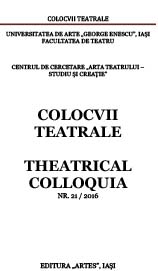Dürrenmatt and The Visit Of The Absurd
Dürrenmatt and The Visit Of The Absurd
Der Besuch Der Alten Dame and En Attendant Godot Interference and Connections
Author(s): Alexandra BandacSubject(s): Theatre, Dance, Performing Arts
Published by: Editura ARTES
Keywords: Friedrich Dürrenmatt; Samuel Beckett; The Visit; Waiting For Godot;
Summary/Abstract: The Visit, perhaps the most famous text written by Friedrich Dürrenmatt, certainly the most played one, is, from my point of view, a theatrical barometer for the mid-XXth-century. Without aiming to quarter the author in a specific theatre tendency or drama school, I cannot help but remark certain similarities of this particular text and other plays written by Dürrenmatt’s contemporaries, and if one may spot the apparent trite of this statement it is, nevertheless, an exciting research path. Inspired by Gogol’s The Government Inspector, preoccupied to reflect the socio-political struggles of his time, faithful to dramatic tradition and yet a vanguardist when it came to the means of expressions, Dürrenmatt juggles with subtle nuances of comedy and tragedy in his works, especially in this particular text (written in 1956), where the combination between the two opposite concepts creates a certain sense of grotesque. From this perspective, the Swiss playwright is thought in mind with Samuel Beckett who, in a similar way, with just three years before (in 1953), presented the public his En attendent Godot, a performance based on a text which was about to blow up the entire theatre perspective of the XXth century. One of Beckett’s favorite ways of creating rhythm within the text is this continuous oscillation between laughter and tears, between comedy and tragedy, the grotesque being one of his recurrent themes. Starting from this point, I shall try to exploit the interference and connections between the texts of Dürrenmatt and Beckett, focusing on their mile-stone creations, which are The Visit and Waiting For Godot.
Journal: Colocvii teatrale
- Issue Year: 2016
- Issue No: 21
- Page Range: 113-120
- Page Count: 8
- Language: Romanian

